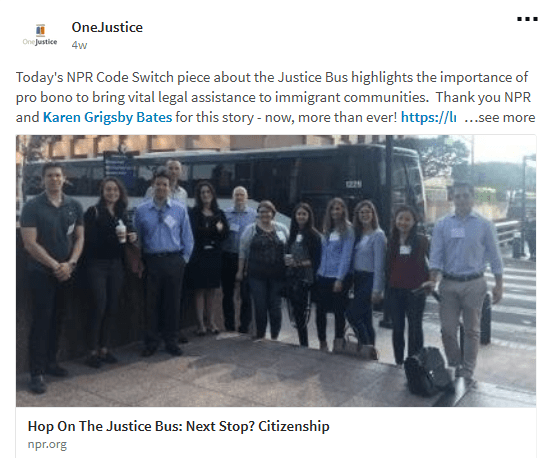
Trust is built by what you do
Trust is the foundation of all lasting relationships.
If you don’t build trust, or if somehow you manage to destroy it, you’re going to lose your donor.
Sadly, this happens more often than not. By now you’re likely familiar with the stats on donor retention from the Fundraising Effectiveness Project. Only 23% of first-time donors renew. Only 46% of all donors, new plus ongoing, renew.
If you want to improve on these retention rates (and you definitely can!), I’m going to suggest you develop a plan to build trust.
Trust is built not simply by what you say, but by what you do. Not just once, but consistently over time.
4 Nonprofit Strategies to Build Donor Trust and Raise More Money
1. Build a Reputation for Following Through on Your Work
Your entire organization is on the hook here.
This is where building a culture of philanthropy becomes truly essential. Everyone involved must understand that donors give only because your organization delivers. They don’t give to support the development department!
I made a point of constantly telling program staff that our fundraising success was truly their success. Not mine. Because they did their jobs so well, people wanted to give. I was simply the middle person.
Program staff must be persuaded to share the news of their on-the-ground work with fundraising and marketing staff so they, in turn, can share it with donors. Otherwise, the vital value-for-value exchange relationship (donor gives money; donor gets value of change enacted) gets short circuited.
TO-DO: Send impact reports that demonstrate you spent your donor’s money exactly the way you said you would. Match your communications to donor intentions. If their giving achieved results, don’t leave donors hanging. Reassure them with repeated thank you’s — letters, blog posts, e-newsletters, stories on your website and social media messaging. If you don’t, they’ll forget all about you and move on to someone who does follow through with them.
2. Build a Reputation for Following Through on Your Promises
Donors expect to hear back from you, promptly, when they give. It’s an unwritten contract.
When they fulfill their end of the bargain, and you don’t fulfill yours, you’ve broken their trust.
But if you do follow through, trust kicks in and kick starts your relationship with your donor. This can begin with the very first thank you landing page, email, letter and/or phone call they receive from you. It continues when you tell them when they can expect to hear from you next, and then you follow through. It’s useful to set up opportunities to build trust.
TO-DO: Force yourself to follow through by promising that you’ll do so! (e.g., “When you make a gift, you will instantly receive a profile of one of the families whose lives are being transformed by this program.”). Then… follow through!
TO-DO: In your thank you letter, note that someone will be calling them within the next two weeks to see if there are other ways they’d like to become involved. Or maybe just let them know you’ll be emailing a roster of volunteer opportunities or upcoming events. Then… follow through!
3. Build a Reputation as a Trusted Resource
People do business with and refer business to those they know, like, and trust. The same holds true for philanthropy. In other words, people give to organizations that have demonstrated they can be trusted.
You build a reputation as a trusted, valued resource by learning as much about what your potential donors care about as you can .
How could you add value to their lives? By solving their problems, of course! This means you’ve got to pay attention to what those problems are. These could be very close to home (like keeping their children or parents safe) or they could be more idealistic (like preventing global warming). Take the time to pay attention to what your constituents’ needs are. You have to be a problem-finder before you can be a problem-solver.
The digital revolution has made this easier than ever before. It’s changed how people learn and how they communicate. Today’s potential donors have access to so much information online, that often they’ve already made a decision to give towards a cause they value before you’re even aware of their existence. The question is which organization will they give to? Be the one that appears most relevant and trustworthy.
There are numerous ways to build a reputation for trustworthiness; here are some of my favorites using social media channels:
TO-DO: Connect with major donors and board members on LinkedIn. See who they follow and what groups they join. Join those groups and see what discussions are trending. Add to the discussion. Focus on helping, not selling. Giving, not taking. That’s how you build trust. That’s how you develop meaningful relationships.
TO-DO: Share relevant research, data and stories about what’s happening on the ground, and what you’re doing to respond. Do this as well in LinkedIn status updates or as direct messages. If you can showcase another authority who showcased you, this is great “social proof” that you’re a viable “player” in the space you occupy.

TO-DO: Don’t just toot your own horn. Sharing what others are doing indicates you’re “in the know” and also collaborative.
 4. Build a Relationship as a Reliable Friend
4. Build a Relationship as a Reliable Friend
Fundraising is personal. You’ve got to be there for folks consistently in a way that’s meaningful to them.
Years ago I worked at a comprehensive, cradle-to-rocking-chair social services agency. Our motto? “When you need us, we’re here for you.” Make that your mantra, whatever your cause.
Your goal should be to become a part of your donors’ lives. Include them, and they’ll include you. Show them they’re important, and that you think and care about them as the blessings they truly are.
This works best when you collect relevant information (formally and informally); then input it into your database. I used to debrief my executive director and board chair weekly to find out what they’d learned about our donors on their travels about town the preceding week. You’d be amazed what I learned about lifecycle events, vacations, job changes, illnesses and the like. You use this information judiciously, of course. Just as you would with any friend.
I’m sure you could brainstorm a whole list of things your nonprofit could do to show you’re paying attention (Extra credit: Do this with a group of board or fundraising volunteers to get them involved in building these relationships. This is a lot of fun for everyone!). These things will be different depending on what your cause is, but they’re exactly what will make you stand apart and will make your donors take notice. Things I’ve done:
- Children’s Services: On their child’s birthday, sent them “How-To’s,” “Checklists,” and “Recommendations” with developmentally appropriate tips and activities based on the age of their child. Also included information about upcoming classes, workshops and activities at our agency.
- Community Center: Sent board and committee members and major donors a birthday coupon good for an ice cream at our on-site café.
- Food bank: Collected freebie gift items over several months from Instaprint; then distributed them to board members at a “just because you’re great” celebration. One, who’d been instrumental in securing fresh produce from surrounding farms, received a car window sticker emblazoned with fruits and veggies saying “Farm to Table.” Others received refrigerator magnets, pens, hats and socks (I actually did this for staff as well).
TO-DO’s:
- Wish people happy birthday or happy anniversary.
- If they have a death or illness in the family, bring soup, send flowers or mail a kind note.
- When their kid graduates, congratulate them with an email, tweet, card or phone call.
- When they go on a trip, email them upon their return to see how they enjoyed their travels.
- Connect with them on LinkedIn so you are notified whenever they celebrate a milestone or switch jobs. Congratulate them. Send them best wishes. Even ask if they’d like to get together for coffee so you can catch up! (I’d do this on LinkedIn because it’s considered a professional site; I’d not do this on Facebook as it could be considered stalking; I’d use judgement with Twitter).
- When you happen upon a perfect (inexpensive) gift for one of your donors, get it for them. Dollar stores are great for this.
Summary
In real estate they say “location, location, location.”
In fundraising it’s “trust, trust, trust.”
Establish trust, and you’ve got the building block you need to cement and sustain a lasting donor relationship.
How do you build trust? Please share your comments below.






How do I fund your year end fund raising tips?
It does cost money to make money. Do an analysis of the long-term value of your supporters (learn how on “Study Fundraising” website). It may be that you’ll find it’s worth investing a bit more on the front end to reap the value of a long-term investor relationship.
valuable recommendation